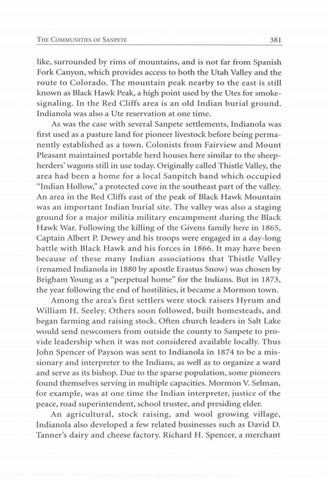like, surrounded by rims of mountains, and is not far from Spanish Fork Canyon, which provides access to both the Utah Valley and the route to Colorado. The mountain peak nearby to the east is still known as Black Hawk Peak, a high point used by the Utes for smokesignaling. In the Red Cliffs area is an old Indian burial ground. Indianola was also a Ute reservation at one time. As was the case with several Sanpete settlements, Indianola was first used as a pasture land for pioneer livestock before being permanently established as a town. Colonists from Fairview and Mount Pleasant maintained portable herd houses here similar to the sheepherders' wagons still in use today. Originally called Thistle Valley, the area had been a home for a local Sanpitch band which occupied "Indian Hollow," a protected cove in the southeast part of the valley. An area in the Red Cliffs east of the peak of Black Hawk Mountain was an important Indian burial site. The valley was also a staging ground for a major militia military encampment during the Black Hawk War. Following the killing of the Givens family here in 1865, Captain Albert P. Dewey and his troops were engaged in a day-long battle with Black Hawk and his forces in 1866. It may have been because of these many Indian associations that Thistle Valley (renamed Indianola in 1880 by apostle Erastus Snow) was chosen by Brigham Young as a "perpetual home" for the Indians. But in 1873, the year following the end of hostilities, it became a Mormon town. Among the area's first settlers were stock raisers Hyrum and William H. Seeley. Others soon followed, built homesteads, and began farming and raising stock. Often church leaders in Salt Lake would send newcomers from outside the county to Sanpete to provide leadership when it was not considered available locally. Thus John Spencer of Payson was sent to Indianola in 1874 to be a missionary and interpreter to the Indians, as well as to organize a ward and serve as its bishop. Due to the sparse population, some pioneers found themselves serving in multiple capacities. Mormon V. Selman, for example, was at one time the Indian interpreter, justice of the peace, road superintendent, school trustee, and presiding elder. An agricultural, stock raising, and wool growing village, Indianola also developed a few related businesses such as David D. Tanner's dairy and cheese factory. Richard H. Spencer, a merchant
Utah Centennial County History Series - Sanpete County 1999

Issuu converts static files into: digital portfolios, online yearbooks, online catalogs, digital photo albums and more. Sign up and create your flipbook.


















